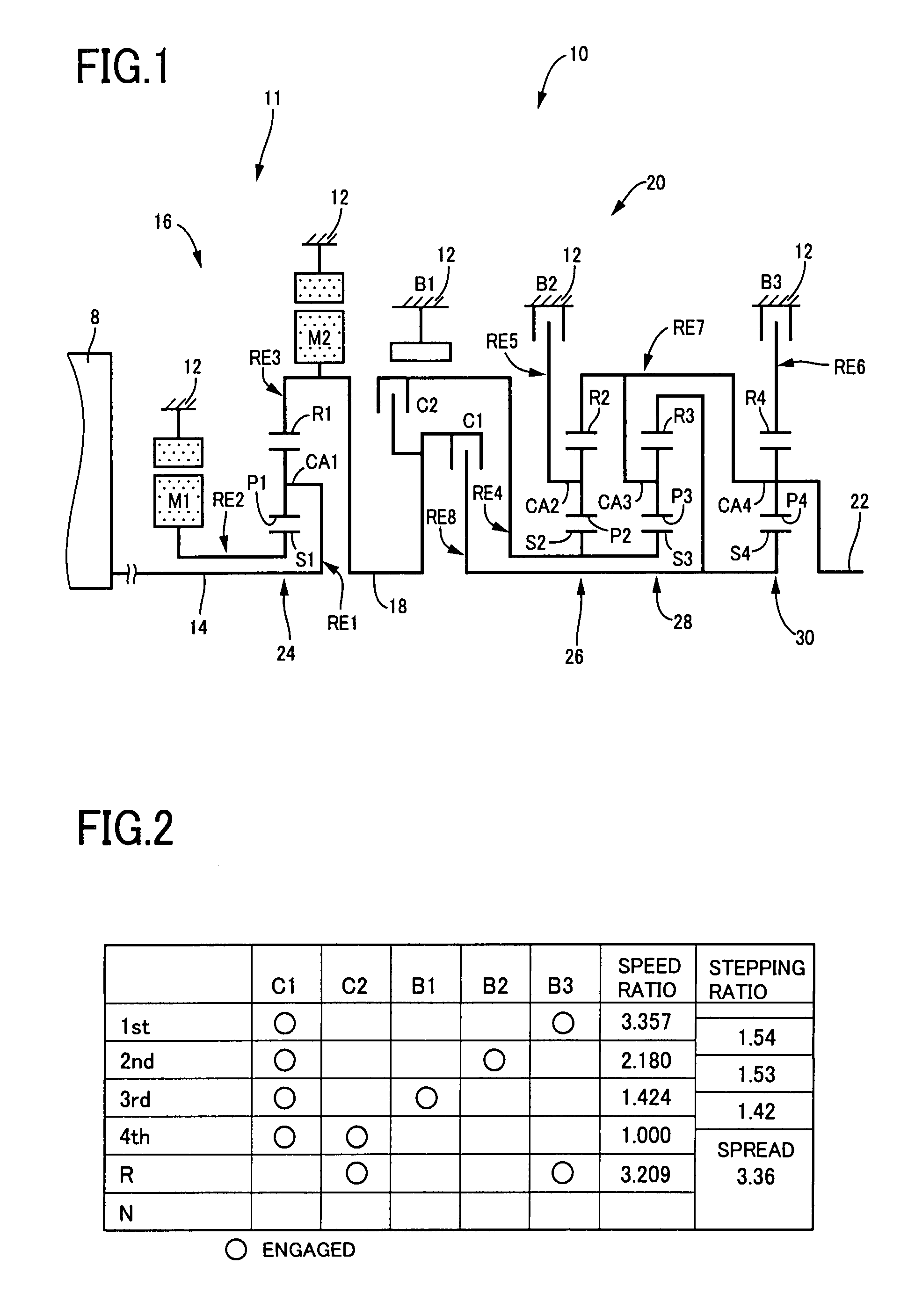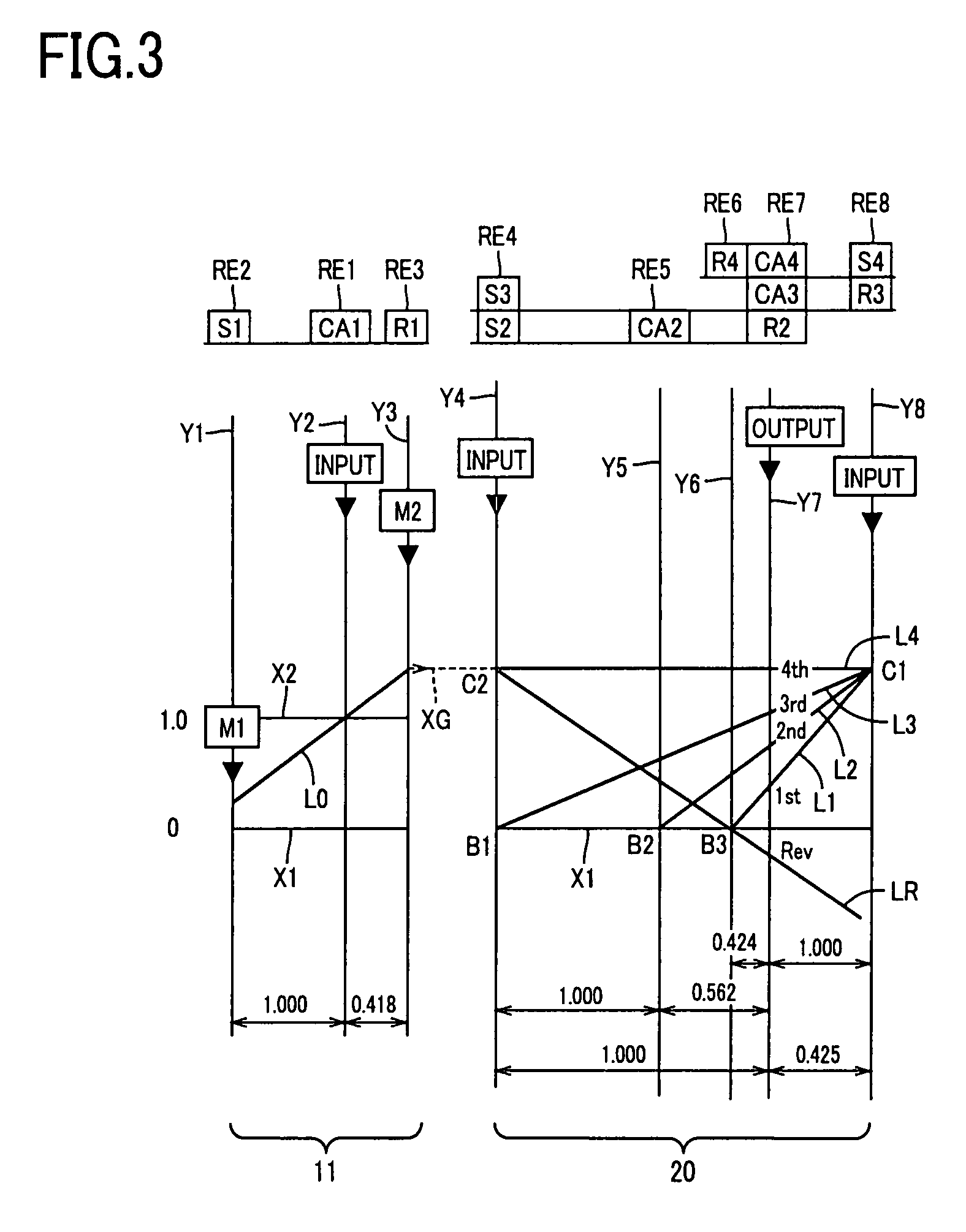Control apparatus for vehicular drive system
a control apparatus and vehicular drive technology, applied in the direction of dynamo-electric gear control, gear control, instruments, etc., can solve the problems of excessive high speed rotation, reduced torque capacity of input clutch, and reduced torque capacity of coupling device, so as to reduce the amount of supply
- Summary
- Abstract
- Description
- Claims
- Application Information
AI Technical Summary
Benefits of technology
Problems solved by technology
Method used
Image
Examples
first embodiment
[0054]Referring to the schematic view of FIG. 1, there is shown a transmission mechanism 10 constituting a part of a drive system for a hybrid vehicle, which drive system is controlled by a control apparatus constructed according to this invention.
[0055]As shown in FIG. 1, the transmission mechanism 10 includes: an input rotary member in the form of an input shaft 14; a continuously-variable transmission portion in the form of an electric differential portion 11 connected to the input shaft 14 either directly, or indirectly via a pulsation absorbing damper (vibration damping device) not shown; a mechanical power transmitting portion in the form of an automatic transmission portion 20 disposed between the electric differential portion 11 and drive wheels 34 (shown in FIG. 7) of the vehicle, and connected in series via a power transmitting member 18 (power transmitting shaft) to the differential 11 and the drive wheels 34; and an output rotary member in the form of an output shaft 22 ...
second embodiment
[0128]In the first embodiment, the upper limit value TEmax2 of the engine output torque TE is held constant. However, the upper limit value TEmax2 may change with the presently established speed ratio γ of the automatic transmission portion 20 such that the upper limit value TEmax2 decreases with an increase of the speed ratio γ. One-dot chain lines in FIG. 10 represent the upper limit values TEmax2 corresponding to the different speed ratio values γ of the automatic transmission portion 20. Alternatively, the upper limit value TEmax2 may change with the rotating speed NM2 of the second electric motor M2 such that the upper limit value TEmax2 decreases with an increase of the rotating speed NM2. Further alternatively, the upper limit value TEmax2 may decrease with an increase of the speed ratio γ and an increase of the rotating speed NM2.
third embodiment
[0129]In the first and second embodiments described above, the upper limit value TEmax of the output torque TE of the engine 8 is abruptly reduced from the normal value TEmax1 to the reduced value TEmax2, when the rotating-speed difference ΔNIN becomes larger than the threshold value ΔNINA, as indicated in FIG. 10. In the present third embodiment, however, the upper limit value TEmax continuously or gradually decreases with an increase of the rotating-speed difference ΔNIN, as indicated by one-dot chain lines in FIG. 12. Alternatively, the upper limit value TEmax may continuously or gradually decrease with an increase of the speed ratio γ of the automatic transmission portion 20. Further alternatively, the upper limit value TEmax2 may decrease with an increase of the rotating speed NM2 and an increase of the speed ratio γ. This embodiment permits a higher degree of stability to prevent the excessive rise of the rotating speed NM2 of the second electric motor M2.
PUM
 Login to View More
Login to View More Abstract
Description
Claims
Application Information
 Login to View More
Login to View More - R&D
- Intellectual Property
- Life Sciences
- Materials
- Tech Scout
- Unparalleled Data Quality
- Higher Quality Content
- 60% Fewer Hallucinations
Browse by: Latest US Patents, China's latest patents, Technical Efficacy Thesaurus, Application Domain, Technology Topic, Popular Technical Reports.
© 2025 PatSnap. All rights reserved.Legal|Privacy policy|Modern Slavery Act Transparency Statement|Sitemap|About US| Contact US: help@patsnap.com



